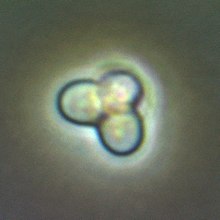| Cyanidioschyzon | |
|---|---|

| |
| Scientific classification | |
| Clade: | Archaeplastida |
| Division: | Rhodophyta |
| Class: | Cyanidiophyceae |
| Order: | Cyanidiales |
| Family: | Cyanidiaceae |
| Genus: | Cyanidioschyzon |
| Species: | C. merolae
|
| Binomial name | |
| Cyanidioschyzon merolae P.De Luca, R.Taddei & L.Varano, 1978[1]
| |
Cyanidioschyzon merolae is a small (2μm), club-shaped, unicellular haploid red alga adapted to high sulfur acidic hot spring environments (pH 1.5, 45 °C).[2][3] The cellular architecture of C. merolae is extremely simple, containing only a single chloroplast and a single mitochondrion and lacking a vacuole and cell wall.[4] In addition, the cellular and organelle divisions can be synchronized. For these reasons, C. merolae is considered an excellent model system for study of cellular and organelle division processes, as well as biochemistry and structural biology.[5][6][7] The organism's genome was the first full algal genome to be sequenced in 2004;[8] its plastid was sequenced in 2000 and 2003, and its mitochondrion in 1998.[9] The organism has been considered the simplest of eukaryotic cells for its minimalist cellular organization.[10]

- ^ «Cyanidioschyzon merolae»: a new alga of thermal acidic environments. P De Luca, R Taddei and L Varano, Webbia, 1978
- ^ De Luca P; Taddei R; Varano L (1978). "Cyanidioschyzon merolae »: a new alga of thermal acidic environments". Journal of Plant Taxonomy and Geography. 33 (1): 37–44. doi:10.1080/00837792.1978.10670110. ISSN 0083-7792.
- ^ Matsuzaki M; Misumi O; Shin-i T; Maruyama S; Takahara M; Miyagishima S; Mori T; Nishida K; Yagisawa F; Nishida K; Yoshida Y; Nishimura Y; Nakao S; Kobayashi T; Momoyama Y; Higashiyama T; Minoda A; Sano M; Nomoto H; Oishi K; Hayashi H; Ohta F; Nishizaka S; Haga S; Miura S; Morishita T; Kabeya Y; Terasawa K; Suzuki Y; Ishii Y; Asakawa S; Takano H; Ohta N; Kuroiwa H; Tanaka K; Shimizu N; Sugano S; Sato N; Nozaki H; Ogasawara N; Kohara Y; Kuroiwa T (2004). "Genome sequence of the ultrasmall unicellular red alga Cyanidioschyzon merolae 10D". Nature. 428 (6983): 653–657. doi:10.1038/nature02398. PMID 15071595.
- ^ Robert Edward Lee (1999). Phycology. Cambridge University Press.
- ^ Kuroiwa T; Kuroiwa H; Sakai A; Takahashi H; Toda K; Itoh R (1998). "The division apparatus of plastids and mitochondria". Int. Rev. Cytol. International Review of Cytology. 181: 1–41. doi:10.1016/s0074-7696(08)60415-5. ISBN 9780123645852. PMID 9522454.
- ^ Kuroiwa (1998). "The primitive red algae Cyanidium caldarium and Cyanidioschyzon merolae as model system for investigating the dividing apparatus of mitochondria and plastids". BioEssays. 20 (4): 344–354. doi:10.1002/(sici)1521-1878(199804)20:4<344::aid-bies11>3.0.co;2-2.
- ^ Cite error: The named reference
Minoda et al 2004was invoked but never defined (see the help page). - ^ Matsuzaki, M.; et al. (2004). "Genome sequence of the ultrasmall unicellular red alga Cyanidioschyzon merolae 10D". Nature. 428 (6983): 653–657. doi:10.1038/nature02398. PMID 15071595.
- ^ Barbier, Guillaume; et al. (2005). "Comparative Genomics of Two Closely Related Unicellular Thermo-Acidophilic Red Algae, Galdieria sulphuraria and Cyanidioschyzon merolae, Reveals the Molecular Basis of the Metabolic Flexibility of Galdieria sulphuraria and Significant Differences in Carbohydrate Metabolism of Both Algae". Plant Physiology. 137 (2): 460–474. doi:10.1104/pp.104.051169. PMC 1065348. PMID 15710685.
- ^ Cite error: The named reference
Kobayashi et al 2010was invoked but never defined (see the help page). - ^ a b Castenholz RW; McDermott TR (2010). "The Cyanidiales: Ecology, Biodiversity, and Biogeography". In Seckbach J; Chapman DJ (eds.). Red Algae in the Genomic Age. pp. 357–371.